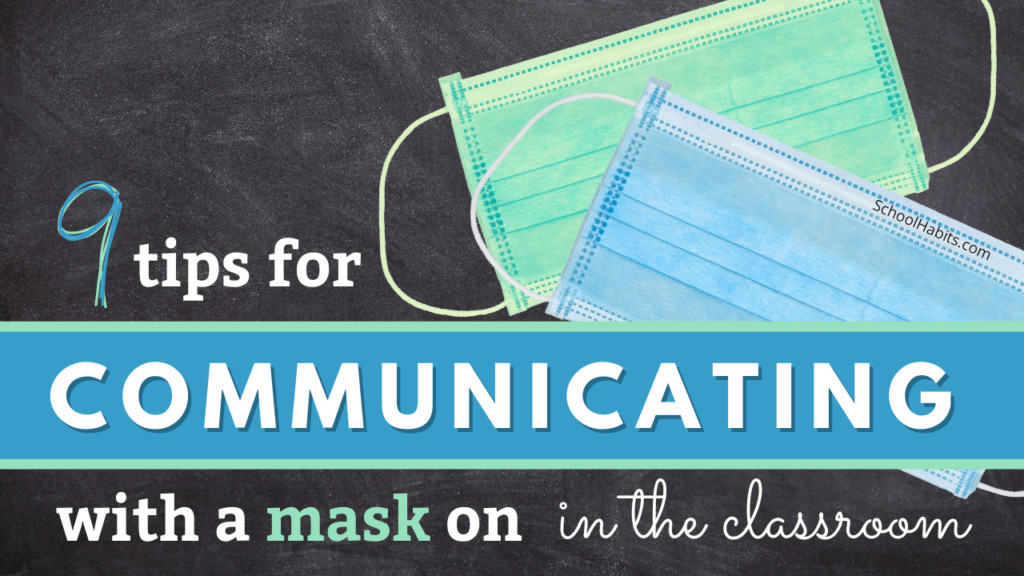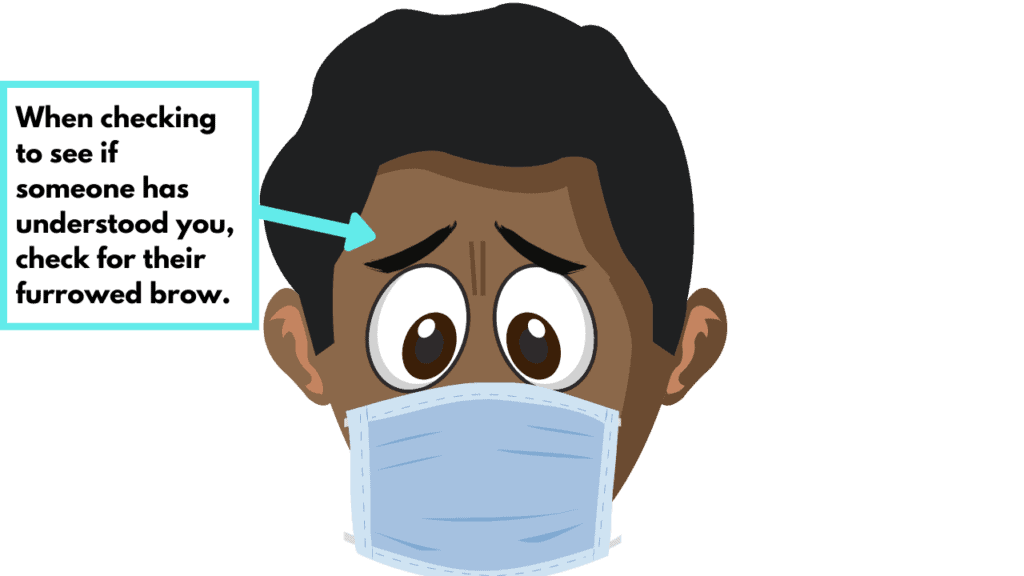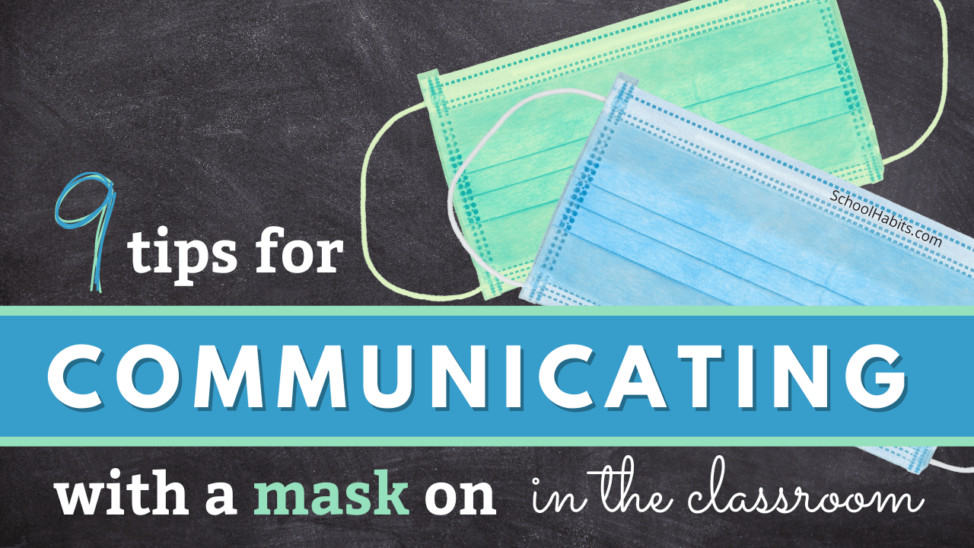
By Katie Azevedo, M.Ed.
Never in a million years would I have predicted that I’d be writing this post. But alas, Covid-19 has made masks as common in the classroom as a stack of papers.
As studies have proven, masks are essential in helping stop the spread of Covid-19. But wearing masks in the classroom poses challenges to how students and teachers communicate.
Communication is more than a verbal exchange of words. Thoughts, feelings and subconscious reactions are communicated via micro facial expressions that are obfuscated with facial coverings, making it difficult for teachers to read non-verbal cues from students, and vice versa.
An example of this type of non-verbal communication in the classroom looks like this:
Pre-COVID: A teacher assigns a reading with questions to be completed in class. A student struggles with the reading but doesn’t speak up for help. The teacher, circulating the room, notices the student biting her lip, frowning, or making some other micro facial expression that indicates she’s struggling. The teacher gently steps in to help.
Intra-COVID: The student is wearing a mask. The teacher does not see the student’s non-verbal cues that suggest she is struggling. The teacher misses the opportunity to help the student.
Whereas masks cover at least one third of the face, thus obscuring the majority of non-verbal communication, students need to modify how they interact in the classroom so that their academic and social needs are still met.
Tips for communicating while wearing a mask in the classroom
1. Maximize eye contact
To get your teacher’s attention or the attention of your peers (during group work), be sure to make direct eye contact with whom you want to communicate. Eye contact is one of the most critical components of communication, and has been proven to be directly related to how others respond to us. Establish eye contact to get someone’s attention, and maintain eye contact once a connection or verbal exchange is established.
If you struggle with self-advocacy (if you find it difficult to express your needs in a timely manner), then establishing eye contact with your teacher in conjunction with an furrowed brow (see image) can send a subtle signal that you need help.
2. Angle your body at the person you’re communicating with
Good eye contact and managing the angle of your body go together, so if you do one, you will likely automatically do the other. But not always … and that’s why this tip is worth mentioning. Whenever you are speaking to someone in the classroom, or whenever you wish to speak to someone in the classroom, face them directly.
If you’re standing, your feet should be pointing in their direction. If you’re sitting, twist your torso if you have to. Facing a person with your body opens a channel for physical, non-verbal communication.
3. Speak loudly and slowly
This may seem obvious, but if you’re trying to communicate while wearing a mask in the classroom, you need to speak louder and more slowly than you would if you were not wearing a mask. Adjusting the volume of your voice might come naturally to some people, but to others, speaking loudly is uncomfortable.
4. Be prepared to repeat yourself
As we know, masks muffle sound. This means that even if you speak loudly and slowly, your voice isn’t going to be crystal clear to the person you’re communicating with. With that said, be prepared to repeat yourself if the other person doesn’t hear you or if they misunderstand you. Be patient and try to find the humor in those awkward situations when you have to repeat something three or four times.
5. Check for understanding
Communicating while wearing a mask in the classroom is not just about expressing yourself clearly, but it’s also about ensuring that the other person has understood you. The most obvious and direct way to ensure that the other person has understood you is to ask a simple follow-up question like “Does that make sense?” Or “Are we clear on this?”

If the situation doesn’t call for a direct question to gauge understanding, then be on the lookout for subtle indicators that you were misunderstood.
Non-verbal clues (from the other person) to look for:
- Responses from the other person that don’t match your message (You: Did you want to work together on this project? Them: I’m fine thanks – how are you?)
- Laughter during non-funny moments
- Silence when you’re expecting a response
- Visible signs of confusion (raised eyebrows, furrowed brow, hand to mouth)
6. Use body language for simple messages
If you need to communicate something simple, use basic body movements to deliver your message instead of or alongside using verbal communication. For example,
- use a thumbs up or thumbs down sign
- raise your hand
- shake your head no or nod your head yes
- exaggerate the use of your eyebrows and eyes
The gestures above are also helpful to use in moments when you would typically just smile. (Remember, smiling is communication!) Your smile is going to be hidden beneath a mask, so accompany your smile with something like a thumbs up sign.
7. Speak up when you don’t understand
It’s important to do your part to ensure that you are understood, but it’s also critical that you understand the other person. To increase your receptive communication, use any of the following strategies:
- Repeat back what the other person said to check for your understanding
- Ask the person to clarify anything you didn’t understand
- Before the conversation is over, summarize the basics
- Listen actively when the other person is talking (no earbuds, face the person, make eye contact)
- Try to move to a quiet location
- Politely ask the person to speak louder (you can signal this request with the universal “I can’t hear you” gesture of cupping your ear with your hand)
If self-advocacy is an on-going problem for you, use these tips here.
8. Use email or written communication
There will be times when you’ve done your best to communicate in-person, but signals still got crossed. In these situations, rely on written communication to clarify misunderstandings. You can write your teachers an email after class, or you can write a question on a sticky note to put on your teacher’s desk during class – whatever the moment calls for.
9. Be patient with yourself and others
Without question, there will be awkward moments of miscommunication between you and your teachers and classmates. These moments can be funny, embarrassing, inconsequential, or critical. It’s important to do what you can to make sure you’re communicating clearly and also to make sure that you’re understanding what’s being communicated to you.
Wearing a mask in the classroom can be challenging and can interfere with typical verbal exchanges between you and your teachers – but this is certainly not a challenge that can’t be overcome with some creativity and effort.
What teachers and clinicians can do to communicate with students while wearing a mask
“Although essential in protecting against COVID-19, mask-wearing can be difficult in understanding speech,” states long-time Speech/Language Pathologist, Candy Kelleher M.ED CCC/SLP. “It makes it difficult to read facial expressions and can cause speech to be challenging to understand.”
Kelleher offers some tips, adapted from the American Speech and Language Association, for teachers who will be communicating with students in the classroom:
- If at all possible, wear a mask with clear mouth panels – something like these
- Capture the attention of your student/client before speaking
- Face students/clients directly and do not turn your backs to them
- Talk slowly and slightly louder
- Enunciate every sound in each word spoken, especially the final sounds in words
- Be expressive with your eyes to show your emotions
- Use body language and gestures such as a thumbs up
- Be sure they understand essential information by asking them to repeat it back to you, or ask them to raise their hand for clarification. You could also write it down or say it in a different way.
- Be in a quiet space so extraneous noise is not competing with your message
- …and lastly, keep smiling and being positive, as children can “see” you even if you’re wearing a mask
As you may notice, communication tips for students are similar to those for teachers, as we all know that communication is a two-way street.
This post is part of a 4-part series about navigating various aspects of school during the time of COVID-19. Check out the other resources in this series:
- Segue to College: Making social connections during COVID-19
- The Peaceful Professor: 8 healthy ways to cope with mask-wearing and improve your mental health
- Collegehood Advice Podcast: 3 ways COVID-19 is getting you ready for college and career
For more SLP advice from Kelleher, find her on social media at @candykelleherSLP

